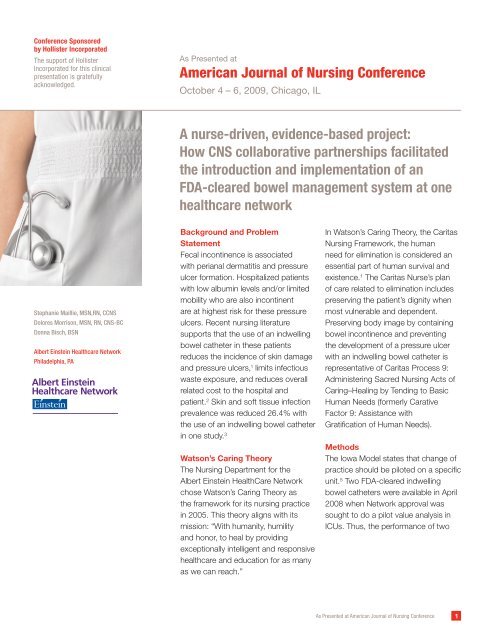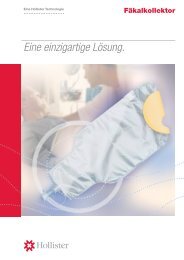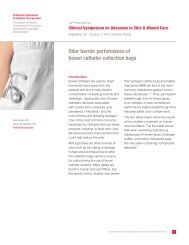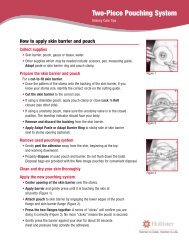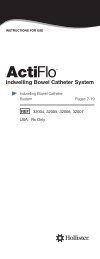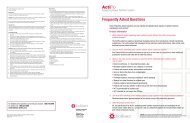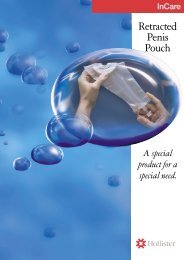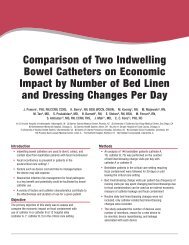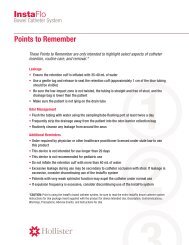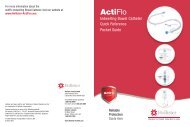A nurse-driven, evidence-based project - Hollister Incorporated
A nurse-driven, evidence-based project - Hollister Incorporated
A nurse-driven, evidence-based project - Hollister Incorporated
You also want an ePaper? Increase the reach of your titles
YUMPU automatically turns print PDFs into web optimized ePapers that Google loves.
Conference Sponsored<br />
by <strong>Hollister</strong> <strong>Incorporated</strong><br />
The support of <strong>Hollister</strong><br />
<strong>Incorporated</strong> for this clinical<br />
presentation is gratefully<br />
acknowledged.<br />
As Presented at<br />
American Journal of Nursing Conference<br />
October 4 – 6, 2009, Chicago, IL<br />
A <strong>nurse</strong>-<strong>driven</strong>, <strong>evidence</strong>-<strong>based</strong> <strong>project</strong>:<br />
How CNS collaborative partnerships facilitated<br />
the introduction and implementation of an<br />
FDA-cleared bowel management system at one<br />
healthcare network<br />
Stephanie Maillie, MSN,RN, CCNS<br />
Dolores Morrison, MSN, RN, CNS-BC<br />
Donna Bisch, BSN<br />
Albert Einstein Healthcare Network<br />
Philadelphia, PA<br />
Background and Problem<br />
Statement<br />
Fecal incontinence is associated<br />
with perianal dermatitis and pressure<br />
ulcer formation. Hospitalized patients<br />
with low albumin levels and/or limited<br />
mobility who are also incontinent<br />
are at highest risk for these pressure<br />
ulcers. Recent nursing literature<br />
supports that the use of an indwelling<br />
bowel catheter in these patients<br />
reduces the incidence of skin damage<br />
and pressure ulcers, 1 limits infectious<br />
waste exposure, and reduces overall<br />
related cost to the hospital and<br />
patient. 2 Skin and soft tissue infection<br />
prevalence was reduced 26.4% with<br />
the use of an indwelling bowel catheter<br />
in one study. 3<br />
Watson’s Caring Theory<br />
The Nursing Department for the<br />
Albert Einstein HealthCare Network<br />
chose Watson’s Caring Theory as<br />
the framework for its nursing practice<br />
in 2005. This theory aligns with its<br />
mission: “With humanity, humility<br />
and honor, to heal by providing<br />
exceptionally intelligent and responsive<br />
healthcare and education for as many<br />
as we can reach.”<br />
In Watson’s Caring Theory, the Caritas<br />
Nursing Framework, the human<br />
need for elimination is considered an<br />
essential part of human survival and<br />
existence. 1 The Caritas Nurse’s plan<br />
of care related to elimination includes<br />
preserving the patient’s dignity when<br />
most vulnerable and dependent.<br />
Preserving body image by containing<br />
bowel incontinence and preventing<br />
the development of a pressure ulcer<br />
with an indwelling bowel catheter is<br />
representative of Caritas Process 9:<br />
Administering Sacred Nursing Acts of<br />
Caring–Healing by Tending to Basic<br />
Human Needs (formerly Carative<br />
Factor 9: Assistance with<br />
Gratification of Human Needs).<br />
Methods<br />
The Iowa Model states that change of<br />
practice should be piloted on a specific<br />
unit. 5 Two FDA-cleared indwelling<br />
bowel catheters were available in April<br />
2008 when Network approval was<br />
sought to do a pilot value analysis in<br />
ICUs. Thus, the performance of two<br />
As Presented at American Journal of Nursing Conference<br />
1
“<br />
In Watson’s Caring Theory, the Caritas Nursing<br />
Framework, the human need for elimination is considered<br />
an essential part of human survival and existence. ”<br />
different indwelling bowel catheter<br />
systems was compared between<br />
June and July 2008, after in-depth<br />
in-servicing on both products in<br />
May 2008. Nurses caring for patients<br />
during the trial were invited to submit<br />
an evaluation form. Ten catheters<br />
each were utilized (20 total) and<br />
18 completed evaluation forms per<br />
bowel catheter system (36 total)<br />
were received.<br />
Results and Evaluation<br />
Product evaluations revealed staff<br />
preference for one system*<br />
because there was less leakage, no<br />
odor, and no catheter displacement.<br />
Albert Einstein HealthCare Network<br />
is a regional leader in kidney, liver,<br />
and pancreas transplantation. Thus,<br />
the overwhelming advantage noted<br />
with the chosen product was the FDA<br />
clearance and ease of medication<br />
administration (lactulose) rectally<br />
with this device.* The Value Analysis<br />
Committee approved network-wide<br />
usage of this product in winter 2008.<br />
Educational/Clinical Rollout<br />
In-services were provided on all<br />
appropriate units and shifts by the<br />
manufacturer’s clinical educator and<br />
the unit CNS. Evidence-<strong>based</strong> order<br />
sets with guidelines were created by<br />
the CNS and a fellow staff <strong>nurse</strong> by<br />
working closely with the manufacturer<br />
and pharmacy. Quarterly Super User<br />
training began in February 2009.<br />
This training is open to all RN staff,<br />
managers, educators, and CNSs,<br />
and is approved for four Continuing<br />
Education units. Course curriculum<br />
includes: description of the order<br />
sets with guidelines; presentation on<br />
product characteristics; inclusion<br />
criteria; contraindications; nursing<br />
interventions for pre-insertion,<br />
maintenance, and removal; aspects of<br />
stool modifi cation; and troubleshooting<br />
for leakage if it occurs. Demonstration<br />
of insertion, maintenance, and removal<br />
is performed on a simulation model<br />
and the indwelling catheter. After<br />
passing a written test, the <strong>nurse</strong><br />
completes return demonstration of<br />
psychomotor skills competency. This<br />
is comprised of two parts: return<br />
demonstration of product insertion,<br />
maintenance, and removal, along with<br />
staff and patient teaching simulation.<br />
Upon passing, the RN receives a<br />
certifi cate and is designated as a<br />
Super User for their unit. To date,<br />
43 Super Users are in the hospital<br />
network. Super Users support the<br />
CNS and staff by acting as an expert<br />
resource and partnering to educate<br />
the staff on the new order sets and<br />
guidelines.<br />
Conclusions and Future Plans<br />
In 2009, a lecture and demonstration<br />
of this indwelling bowel management<br />
system was incorporated into the<br />
New RN Skin Day Class. This product<br />
competency is also now becoming<br />
a required station at Unit-Based<br />
Skills Days. Continuing Education<br />
with quarterly Super User training<br />
is planned for 2010-2011. An<br />
<strong>evidence</strong>-<strong>based</strong> policy and procedure<br />
document is currently being created<br />
in collaboration with a staff RN, and<br />
will be reviewed and approved by<br />
the Nursing Policy and Procedure<br />
Committee of the Shared Governance<br />
System. Product evaluations by the<br />
end users are currently being collected<br />
and reviewed for a one-year post<br />
analysis.<br />
2<br />
As Presented at American Journal of Nursing Conference
The support of <strong>Hollister</strong><br />
<strong>Incorporated</strong> for this clinical<br />
presentation is gratefully<br />
acknowledged.<br />
ActiFlo Indwelling Bowel Catheter System<br />
References<br />
1. Benoit RA, Watts C. The effect of a pressure<br />
ulcer prevention program and the bowel<br />
management system in reducing pressure<br />
ulcer prevalence in an ICU setting. Journal<br />
of WOCN. 2007; 34(2):163-175.<br />
2. Kowal-Vern A, et al. Fecal containment in<br />
bedridden patients: economic impact of<br />
two commercial bowel catheter systems.<br />
American Journal of Critical Care.<br />
Supplement to May 2009; 18(3):S2-S15.<br />
3. Echols J, et al. Clinical utility and economic<br />
impact of introducing a bowel management<br />
system. Journal of WOCN. 2007;<br />
34(6):664-670.<br />
4. Watson J. Nursing: The Philosophy and<br />
Science of Caring, revised edition. (Boulder:<br />
Colorado Associated University Press, 2008).<br />
5. Titler MG, et al. The Iowa model of<br />
<strong>evidence</strong>-<strong>based</strong> practice to promote<br />
quality care. Critical Care Nurs Clinics<br />
of North America. 2001; 13(4):497-509.<br />
Acknowledgements<br />
Without the true collaboration of the following<br />
AEHN departments, this <strong>project</strong> would not have<br />
been a success: Department of Critical Care<br />
Nursing; Value Analysis, Pharmacy, Forms and<br />
CIMOC Committee; and Nursing Education and<br />
Professional Development.<br />
Product evaluations by the end users were collected and<br />
reviewed for a one-year post analysis<br />
As Presented at American Journal of Nursing Conference<br />
3
ActiFlo Indwelling Bowel Catheter System<br />
Product Information<br />
NON STERILE: Single patient use only. Latex-free.<br />
CAUTION: Federal (USA) Law restricts this device to sale by or on<br />
the order of a physician. Prior to use of the ActiFlo indwelling bowel<br />
catheter system, be sure to read the entire ActiFlo indwelling bowel<br />
catheter system Instructions for Use package insert supplied with<br />
the product for device Intended Use, Description, Contraindications,<br />
Warnings, Precautions, Adverse Events, and Instructions for Use.<br />
INTENDED USE<br />
The ActiFlo indwelling bowel catheter system is intended for<br />
diversion of fecal matter to minimize contact with the patient’s<br />
skin, to facilitate the collection of fecal matter for patients requiring<br />
bowel management, to provide access for colonic irrigation, and to<br />
administer enema/medications.<br />
CONTRAINDICATIONS<br />
• Do not use in patients having known sensitivities or allergies<br />
to the materials used in this device.<br />
• Do not use if the patient’s distal rectum cannot accommodate<br />
the infl ated volume of the retention cuff or if the distal rectum/<br />
anal canal is severely strictured (e.g., secondary to tumor,<br />
infl ammatory condition, radiation injury, scarring).<br />
• Do not use on patients having impacted stool.<br />
• Do not use on patients with a recent (less than 6 weeks old)<br />
rectal anastomosis, or a recent (less than 6 weeks old) anal<br />
or sphincter reconstruction.<br />
• Do not use on patients with compromised rectal wall integrity<br />
(e.g., ischemic proctitis).<br />
WARNINGS<br />
(Failure to comply with the following warnings may result<br />
in patient injury)<br />
• Do not use if package is open or damaged.<br />
• Do not use improper amount or type of fl uids for irrigation<br />
or cuff/balloon infl ations. NEVER use hot liquids.<br />
• Do not over infl ate retention cuff or intraluminal balloon.<br />
• Infl ation of the intraluminal balloon causes complete catheter<br />
occlusion. Do not leave intraluminal balloon infl ated in an<br />
unattended patient. To verify complete defl ation of the<br />
intraluminal balloon, aspirate all air until RED connector<br />
(STOP FLOW 25 mL AIR) pilot balloon is collapsed when<br />
the syringe is removed from the connector.<br />
• Use only gravity or slow manual irrigation. Do not connect<br />
manual pumping devices to catheter irrigation lumen. Do not<br />
irrigate patient with compromised intestinal wall integrity.<br />
• Extreme caution should be exercised in patients at risk for the<br />
development of toxic megacolon. Occluding the tube by infl ating<br />
the intraluminal balloon could aggravate this situation.<br />
• Perform irrigations, and enema/medication administrations,<br />
via the CLEAR connector (IRRIG/Rx) AND NOT via the BLUE<br />
connector (CUFF 35-40 mL H2O) or RED connector<br />
(STOP FLOW 25 mL AIR).<br />
• Blood per rectum should be investigated to ensure no <strong>evidence</strong><br />
of pressure necrosis from the device. Discontinue use of the<br />
device if evident.<br />
• Abdominal distention that occurs while using the device should<br />
be investigated.<br />
• The section of the catheter that crosses the anal canal<br />
(transsphincteric zone) is made of softcollapsible material<br />
designed to help avoid impact on the rectal sphincter. Excessive<br />
prolonged traction on the catheter, resulting in the retention<br />
cuff migrating into the anal canal, could result in temporary or<br />
permanent clinical sphincter dysfunction, or catheter expulsion.<br />
PRECAUTIONS<br />
• Do not sterilize.<br />
• The ActiFlo indwelling bowel catheter is not intended for use<br />
longer than 29 days.<br />
• The ActiFlo indwelling bowel catheter is not recommended<br />
for pediatric use.<br />
• To avoid damage to retention cuff or intraluminal balloon,<br />
DO NOT contact either with ANY sharp edge including the<br />
enclosed lubricating jelly packets.<br />
• The ActiFlo indwelling bowel catheter may not be effective in<br />
individuals who have had their distal rectum signifi cantly altered<br />
by surgical resection or reconstruction.<br />
• Patients with very weak sphincter function may expel the<br />
catheter under normal use, or may have increased leakage<br />
of stool or irrigation fl uids compared to patients with normal<br />
sphincter function.<br />
• Caution should be observed in patients whose rectum<br />
may be altered by stricture due to radiation or affected with<br />
radiation proctitis.<br />
• Patients with severe tenesmus, or patients who experience<br />
tenesmus or severe pain after insertion of device, may not<br />
tolerate the catheter in place.<br />
• Avoid inserting anything (e.g., thermometer, suppository, etc.)<br />
into the anal canal with the catheter in place to minimize patient<br />
injury or catheter damage.<br />
• Care should be taken when disconnecting syringe from<br />
the CLEAR connector (IRRIG/Rx). Fluids that are retained in the<br />
rectum and colon may drain or splatter from the connector when<br />
it is disconnected.<br />
• Use water only to infl ate retention cuff. Do not use saline<br />
solution, which may adversely affect valve function.<br />
• Use air only to infl ate the intraluminal balloon. Do not use water<br />
or any other fl uid.<br />
• Do not use vigorous aspiration to remove fl uid from the retention<br />
cuff or to remove air from the intraluminal balloon. Vigorous<br />
aspiration may collapse the infl ation lumen and/or pilot balloon<br />
and prevent retention cuff or intraluminal balloon defl ation.<br />
• Do not allow ointments or lubricants having a petroleum base<br />
(e.g., Vaseline®, petroleum<strong>based</strong> hand/body lotion) to<br />
contact the catheter. They may damage the silicone and may<br />
compromise the integrity of the device.<br />
• Use only ActiFlo collection bags with the ActiFlo<br />
indwelling bowel catheter.<br />
• Feces contains infectious material. Protect caregiver and others<br />
from splatter which may occur when disconnecting or emptying<br />
the collection bags or during catheter removal.<br />
• After use, this system is a biohazard. Handle and dispose<br />
of in accordance with institutional universal precautions for<br />
contaminated waste.<br />
ADVERSE EVENTS<br />
The following adverse events may be associated with the use<br />
of any rectal device:<br />
• Perforation<br />
• Pressure necrosis<br />
• Loss of sphincter tone<br />
• Obstruction<br />
• Infection<br />
• Excessive leakage of fecal contents<br />
<strong>Hollister</strong> <strong>Incorporated</strong><br />
Libertyville, IL USA<br />
For detailed clinical questions<br />
concerning our products:<br />
1.888.740.8999<br />
For orders only: 1.800.323.4060<br />
Distributed by<br />
<strong>Hollister</strong> Limited<br />
Aurora, Ontario<br />
1.800.263.7400<br />
www.hollister.com<br />
<strong>Hollister</strong> and logo, <strong>Hollister</strong><br />
and ActiFlo are trademarks of<br />
<strong>Hollister</strong> <strong>Incorporated</strong>.<br />
©2012 <strong>Hollister</strong> <strong>Incorporated</strong>.<br />
910972-1112<br />
4 As Presented at American Journal of Nursing Conference


